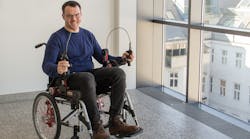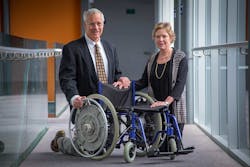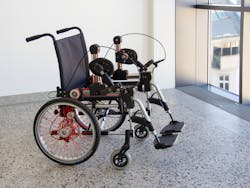A common problem among wheelchair users is the physical stress their hands and arms are subjected to. The typical propulsion method of using one’s arms to rotate the wheels is unnatural and puts a significant strain on the human body.
Dr. Claire Flemmer, a professor at the School of Engineering and Advanced Technology at Massey University, describes the pressure this puts on the human operator. “Manual wheelchairs require an inefficient push effort, where the user grips either the wheel or a slightly smaller rim on the outside—called the pushrim—and propels the chair forward by pushing the rim until they are forced let go and repeat the action,” Flemmer says. “This means only about 25% of the action actually contributes to the chair going forward.
“This method causes an imbalanced repetitive strain on the shoulders and wrists that can lead to chronic pain,” she continues. “The longer a person uses the manual wheelchair, the worse it gets.” In attempts to alleviate these pains, engineers have taken to redesign the modern wheelchair with ergonomic features.
Drs. Roy and Claire Flemmer designed the Ezy-Wheels wheelchair to help reduce the strain on the human body. The chair employs a three-gear system which is driven with a push-and-pull movement, allowing the operator's hands to never have to leave the pushrim. (Credit: Massey University)
Ezy-Wheels Creates a Push-and-Pull Movement
Ezy-Wheels is a new wheelchair design from Flemmer and her husband, Dr. Roy Flemmer. It employs an innovative propulsion method that allows the user’s hands to lay on the pushrim without having the need to pick them up. The new design improves upon stroking efficiency by using 100% of the total arm movement and looks to minimize chronic shoulder and wrist problems, as well as making it easier to travel uphill.
The basic movement of the new chair design requires the user to push and pull on the pushrim rather than just push forward. The advanced gear system in the chair allows for this movement and always lets the user keep their hands on the pushrim. The chair has two modes of movement: a standard and a run mode. The run mode is designed for use on long journeys and challenging terrains. It employs a three-gear system much like a bicycle. The high gear is used when the path is easy (either flat or downhill), and the low gear is for when the path is harder (either uphill or a tarred path). Run mode prevents the chair from rolling backward when located on a slope.
Hand Gear-Driven Wheelchair
“The motion sequence when using a wheelchair is usually quite unnatural,” explains Prof. Margit Gföhler from the Institute of Engineering Design and Product Development at TU Wien University. To change the motion of wheelchairs, the research team for biomechanics and rehabilitation at TU Wien have developed a new drive system that uses a hand gear propulsion system. The hand gear system is more ergonomic and better-suited for natural movement patterns of the upper body.
Gföhler and her research team developed a biomechanical computer that analyzed various motion sequences of the upper human body. The computer determined that the best motion sequence resulted in a mechanical drive system driven by two hand gears. During each revolution, the levers change their length creating an egg-shaped movement in comparison to a circular one. The hand gears are mounted on the wheelchair’s armrests and drive the rear wheels via a toothed belt. This allows for a more compact design with smaller wheels, making it suitable for everyday indoor use.
The hand gear wheelchair design from TU Wein University was created after a biomechanical computer model analyzed the human body’s upper movements. The result was a wheelchair design operated via hand gears mounted on the armrests. (Credit: TU Wein University)
The chair has already been tested in the ‘Weißer Hof’ rehabilitation center in Klosterneuburg, Austria. Spirometry tests were performed to measure the breathing of the user while using the new chair. The new drive technology was able to achieve the same speeds as a regular wheelchair but with a significantly reduced effort. “The responses were very positive,” says Gföhler “People were pleased that their joints no longer have to move outside the natural angular range and that the wheelchair enables continuous movement without interruption.”
With these new chair designs coming soon to market, users of wheelchairs will be able to enjoy more efficient systems of maneuverability.



